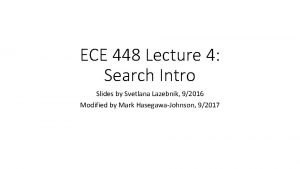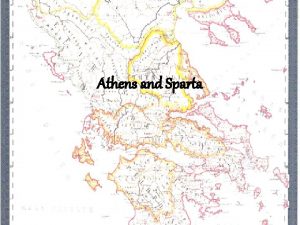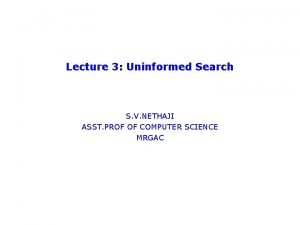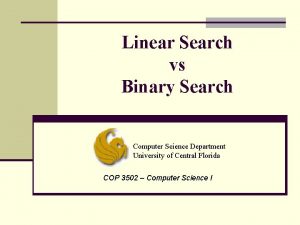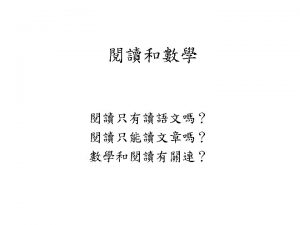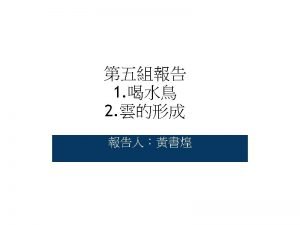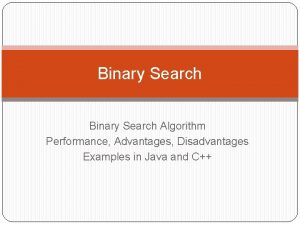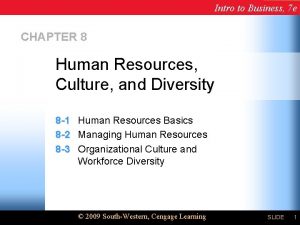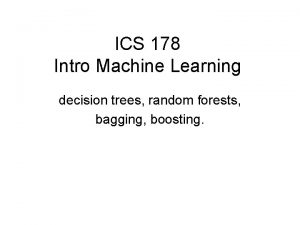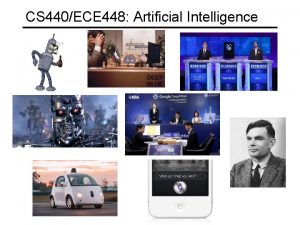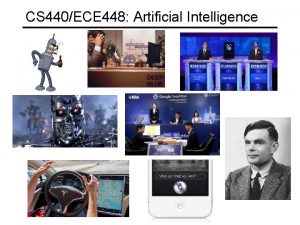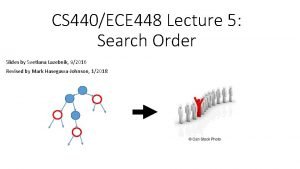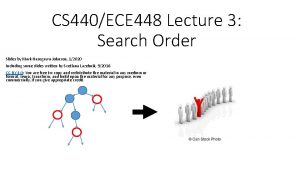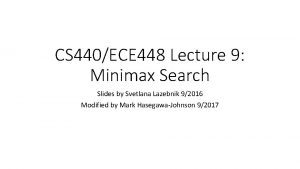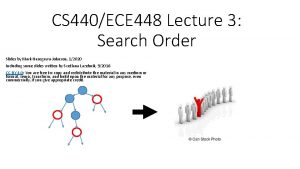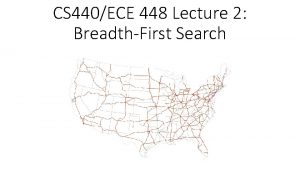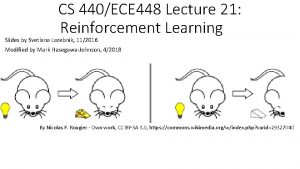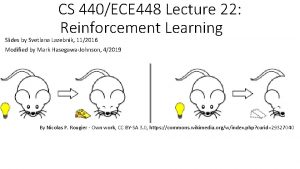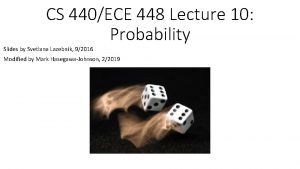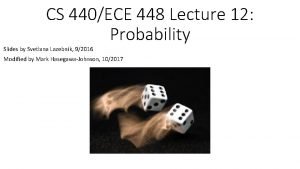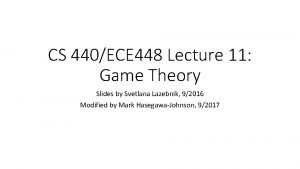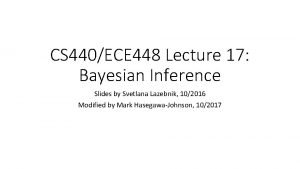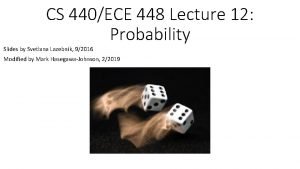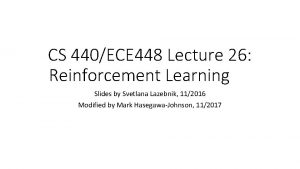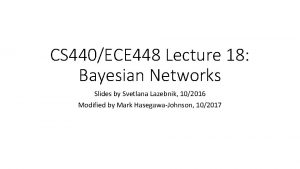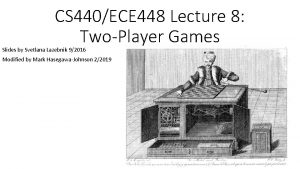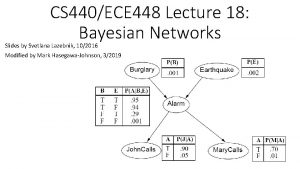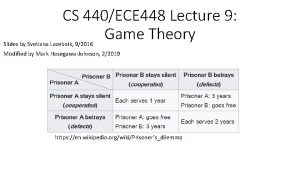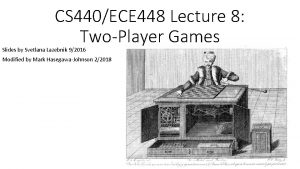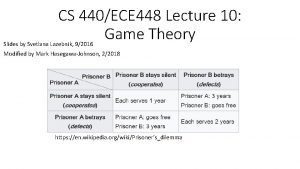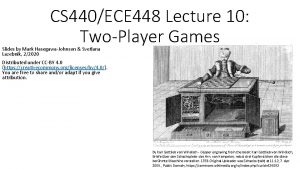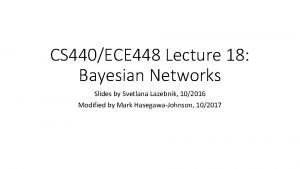CS 440ECE 448 Lecture 4 Search Intro Slides




































- Slides: 36

CS 440/ECE 448 Lecture 4: Search Intro Slides by Svetlana Lazebnik, 9/2016 Modified by Mark Hasegawa-Johnson, 9/2017

Types of agents Reflex agent • Consider how the world IS • Choose action based on current percept • Do not consider the future consequences of actions Goal-directed agent • Consider how the world WOULD BE • Decisions based on (hypothesized) consequences of actions • Must have a model of how the world evolves in response to actions • Must formulate a goal Source: D. Klein, P. Abbeel

Outline of today’s lecture 1. How to turn ANY problem into a SEARCH problem: 1. Initial state, goal state, transition model 2. Actions, path cost 2. General algorithm for solving search problems 1. First data structure: a frontier list 2. Second data structure: a search tree 3. Third data structure: a “visited states” list

Search • We will consider the problem of designing goal-based agents in fully observable, deterministic, discrete, static, known environments Start state Goal state

Search We will consider the problem of designing goal-based agents in fully observable, deterministic, discrete, known environments • The agent must find a sequence of actions that reaches the goal • The performance measure is defined by (a) reaching the goal and (b) how “expensive” the path to the goal is • The agent doesn’t know the performance measure. This is a goaldirected agent, not a utility-directed agent • The programmer (you) DOES know the performance measure. So you design a goal-seeking strategy that minimizes cost. • We are focused on the process of finding the solution; while executing the solution, we assume that the agent can safely ignore its percepts (static environment, open-loop system)

Search problem components • Initial state • Actions • Transition model Initial state • What state results from performing a given action in a given state? • Goal state • Path cost • Assume that it is a sum of nonnegative step costs Goal state • The optimal solution is the sequence of actions that gives the lowest path cost for reaching the goal

Knowledge Representation: State • State = description of the world • Must have enough detail to decide whether or not you’re currently in the initial state • Must have enough detail to decide whether or not you’ve reached the goal state • Often but not always: “defining the state” and “defining the transition model” are the same thing

Example: Romania • On vacation in Romania; currently in Arad • Flight leaves tomorrow from Bucharest • Initial state • Arad • Actions • Go from one city to another • Transition model • If you go from city A to city B, you end up in city B • Goal state • Bucharest • Path cost • Sum of edge costs (total distance traveled)

State space • The initial state, actions, and transition model define the state space of the problem • The set of all states reachable from initial state by any sequence of actions • Can be represented as a directed graph where the nodes are states and links between nodes are actions • What is the state space for the Romania problem?

Example: Vacuum world • States • Agent location and dirt location • How many possible states? • What if there are n possible locations? • The size of the state space grows exponentially with the “size” of the world! • Actions • Left, right, suck • Transition model

Vacuum world state space graph

Complexity of the State Space •

Example: The 8 -puzzle • States • Locations of tiles • 8 -puzzle: 181, 440 states (9!/2) • 15 -puzzle: ~10 trillion states • 24 -puzzle: ~1025 states • Actions • Move blank left, right, up, down • Path cost • 1 per move • Finding the optimal solution of n-Puzzle is NP-hard

Example: Robot motion planning • States • Real-valued joint parameters (angles, displacements) • Actions • Continuous motions of robot joints • Goal state • Configuration in which object is grasped • Path cost • Time to execute, smoothness of path, etc.

Traveling Salesman Problem • Goal: visit every city in the United States • Path cost: total miles traveled • Initial state: Champaign, IL • Action: travel from one city to another • Transition model: when you visit a city, mark it as “visited. ”

Outline of today’s lecture 1. How to turn ANY problem into a SEARCH problem: 1. Initial state, goal state, transition model 2. Actions, path cost 2. General algorithm for solving search problems 1. First data structure: a frontier list 2. Second data structure: a search tree 3. Third data structure: a “visited states” list

Search • Given: • • • Initial state Actions Transition model Goal state Path cost • How do we find the optimal solution? • How about building the state space and then using Dijkstra’s shortest path algorithm? • Complexity of Dijkstra’s is O(E + V log V), where E is the number of transitions, V is the number of states • Usually, V = O{2^{# variables you need to keep track of}} • Therefore the shortest-path algorithm is exponential in the # variables

Tree Search: Basic idea • Let’s begin at the start state and expand it by making a list of all possible successor states • Maintain a frontier or a list of unexpanded states • At each step, pick a state from the frontier to expand (EXPAND = list all of the other states that can be reached from this state) • Keep going until you reach a goal state • BACK-TRACE: go back up the tree; list, in reverse order, all of the actions you need to perform in order to reach the goal state. • ACT: the agent reads off the sequence of necessary actions, in order, and does them.

Search tree • “What if” tree of sequences of actions and outcomes • The root node corresponds to the starting state • The children of a node correspond to the successor states of that node’s state Starting state Action Successor state • A path through the tree corresponds to a sequence of actions • A solution is a path ending in the goal state • Nodes vs. states • A state is a representation of the world, while a node is a data structure that is part of the search tree • Node has to keep pointer to parent, path cost, possibly other info … … … Goal state …

Knowledge Representation: States and Nodes • State = description of the world • Must have enough detail to decide whether or not you’re currently in the initial state • Must have enough detail to decide whether or not you’ve reached the goal state • Often but not always: “defining the state” and “defining the transition model” are the same thing • Node = a point in the search tree • Private data: ID of the state reached by this node • Private data: the ID of the parent node, and of all child nodes

Search: Computational complexity •

Tree Search Algorithm Outline • Initialize the frontier using the starting state • While the frontier is not empty • Choose a frontier node according to search strategy and take it off the frontier • If the node contains the goal state, return solution • Else expand the node and add its children to the frontier

Tree search example Start: Arad Goal: Bucharest

Tree search example Start: Arad Goal: Bucharest

Tree search example Start: Arad Goal: Bucharest

Tree search example Start: Arad Goal: Bucharest

Tree search example Start: Arad Goal: Bucharest e

Tree search example Start: Arad Goal: Bucharest e

Handling repeated states • Initialize the frontier using the starting state • While the frontier is not empty • Choose a frontier node according to search strategy and take it off the frontier • If the node contains the goal state, return solution • Else expand the node and add its children to the frontier • To handle repeated states: • Every time you expand a node, add that state to the explored set; do not put explored states on the frontier again • Every time you add a node to the frontier, check whether it already exists in the frontier with a higher path cost, and if yes, replace that node with the new one

Tree search w/o repeats Start: Arad Goal: Bucharest

Tree search w/o repeats Explored: Arad Start: Arad Goal: Bucharest

Tree search example Explored: Arad Sibiu Start: Arad Goal: Bucharest

Tree search example Explored: Arad Sibiu Rimnicu Vilces Start: Arad Goal: Bucharest

Tree search example Explored: Arad Sibiu Rimnicu Vilces Fagaras Start: Arad Goal: Bucharest e

Tree search example Explored: Arad Sibiu Rinnicu Vilces Fagaras Pitesti Start: Arad Goal: Bucharest e

Our first computational savings: avoid repeated states • Complexity if you allow repeated states: mantissa = number of states you can transition to from any source state, exponent = depth of the tree • Complexity if you don’t allow repeated states: never larger than the total number of states in the world • For a maze search: # states = # positions you can reach, therefore avoiding repeated states might be all the computational savings you need • For a task with multiple sub-tasks, e. g. , search a maze while cleaning dirt: # states is exponential in the # sub-tasks, therefore we still need better algorithms. That’s the topic for next week.
 A small child slides down the four frictionless slides
A small child slides down the four frictionless slides Starting from rest a marble first rolls down
Starting from rest a marble first rolls down Business communication lecture slides
Business communication lecture slides Principles of economics powerpoint lecture slides
Principles of economics powerpoint lecture slides Cmu machine learning
Cmu machine learning 01:640:244 lecture notes - lecture 15: plat, idah, farad
01:640:244 lecture notes - lecture 15: plat, idah, farad Cs 448
Cs 448 Jest głównym dopływem wisły ma 448 km długości
Jest głównym dopływem wisły ma 448 km długości Ece 448
Ece 448 Ece 448
Ece 448 Cs 448
Cs 448 Ece 448
Ece 448 Ece 448
Ece 448 Info 448
Info 448 Vhdl asic
Vhdl asic Afsc 448 scmw saspo
Afsc 448 scmw saspo Ece 448
Ece 448 500-448
500-448 Factors of 448
Factors of 448 Blind search dan heuristic search
Blind search dan heuristic search Comparison of uninformed search strategies
Comparison of uninformed search strategies Comparison of uninformed search strategies
Comparison of uninformed search strategies What is informed search and uninformed search
What is informed search and uninformed search Gravity yahoo
Gravity yahoo Linear search vs binary search
Linear search vs binary search Unified search vs federated search
Unified search vs federated search 1http
1http Https://images.search.yahoo.com/search/images
Https://images.search.yahoo.com/search/images Tw.search.yahoo.com
Tw.search.yahoo.com Tw yahoo news
Tw yahoo news Local search vs global search
Local search vs global search Best first search in ai
Best first search in ai Multilingual semantical markup
Multilingual semantical markup Advantages and disadvantages of binary search tree
Advantages and disadvantages of binary search tree Federated search vs distributed search
Federated search vs distributed search Intro to business chapter 8
Intro to business chapter 8 Random forest intro
Random forest intro









